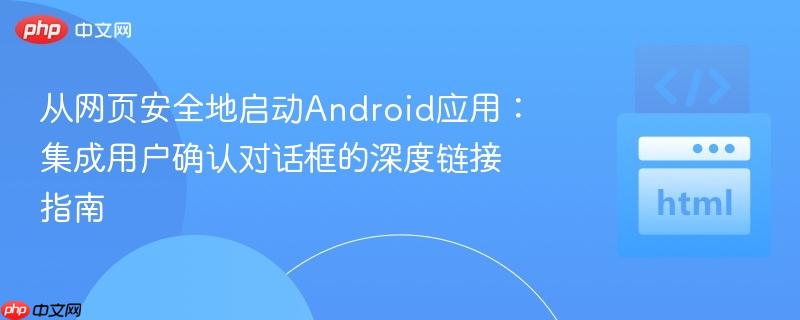
本文详细阐述了如何通过网页安全地启动 android 应用程序,并在此过程中引入用户确认对话框以提升体验。我们将探讨 android intent uri 的构建,并提供一个完整的html、css 和javascript示例,演示如何创建一个模态对话框,在用户确认后才触发应用的深度链接,同时包含关键注意事项。
引言:深度链接与用户体验
深度链接(Deep Linking)是移动 应用开发 中的一项关键技术,它允许用户通过网页链接直接跳转到移动应用程序的特定内容页面,极大地提升了用户体验和内容的可发现性。然而,在某些场景下,直接从网页启动应用可能会让用户感到突兀,尤其是在用户不确定链接会执行什么操作时。为了增强用户控制感和提升安全性,引入一个用户确认对话框(Modal Dialog)成为了一种优雅的解决方案,它能在启动应用前提供一个明确的提示,让用户决定是否继续。
Android Intent URI 深度解析
Android 系统通过 Intent 机制来实现应用程序组件之间的通信,包括从外部(如网页 浏览器)启动应用。网页端可以通过特定的 intent:// URI 格式来触发 Android 应用的深度链接。
Intent URI 结构
intent:// URI 的基本结构如下:
intent://[HOST][PATH]#Intent;scheme=[SCHEME];action=[ACTION];[CATEgoRY];[PACKAGE];[COMPONENT];[EXTRA];end其中,关键组成部分包括:
- scheme: 这是最核心的部分,定义了您的 Android 应用在 AndroidManifest.xml 中声明的自定义 URI 方案(例如 my_scheme)。当 浏览器 遇到此 scheme 时,系统会尝试查找能处理该 scheme 的应用。
- host: 位于 scheme:// 之后,用于进一步 路由 到应用内的特定功能或模块(例如 my_host)。
- action: 可选,指定要执行的动作(例如 my_action),对应于应用 AndroidManifest.xml 中 <intent-Filter> 声明的 android:name 属性。
- category: 可选,提供关于 Intent 类型的额外信息。
- package: 可选,指定目标应用的包名,如果设置,只有该包名的应用才能响应此 Intent。
- component: 可选,直接指定目标组件的完整类名。
- extra: 可选,通过 key=value 形式传递额外数据。
示例 Intent URI:
在本文的场景中,我们使用的 Intent URI 格式为:intent://my_host#Intent;scheme=my_scheme;action=my_action;end
这意味着浏览器将尝试启动一个能够处理 my_scheme://my_host URI,并且声明了 my_action 动作的 Android 应用。
构建网页端用户确认对话框
为了在启动 Android 应用前提供用户确认,我们可以在网页上实现一个模态对话框。这个对话框将在用户点击触发链接时弹出,并提供“打开”和“取消”两个选项。
实现原理
- html 结构: 创建一个隐藏的模态对话框容器,包含标题、提示信息、以及“打开”和“取消”按钮。
- css 样式: 定义模态对话框的样式,使其覆盖整个页面并居中显示,通常伴随一个半透明的背景遮罩。
- javaScript 逻辑:
- 监听触发深度链接的按钮或链接的点击 事件。
- 当事件发生时,通过 javascript 显示模态对话框。
- 为模态对话框中的“打开”按钮添加点击事件监听器,当用户点击时,执行 window.location.href = androidIntentURI; 来启动应用,并关闭对话框。
- 为“取消”按钮添加点击事件监听器,当用户点击时,仅关闭对话框。
完整的实现示例
以下是一个包含 HTML、CSS 和 JavaScript 的完整示例,展示了如何在网页上实现这一功能:
<!DOCTYPE html> <html lang="zh-CN"> <head> <meta charset="UTF-8"> <meta name="viewport" content="width=device-width, initial-scale=1.0"> <title> 从网页启动 Android 应用 </title> <style> body {font-family: Arial, sans-serif; display: flex; justify-content: center; align-items: center; min-height: 100vh; margin: 0; background-color: #f0f2f5;} /* 触发按钮样式 */ .trigger-btn {padding: 15px 30px; font-size: 18px; background-color: #007bff; color: white; border: none; border-radius: 5px; cursor: pointer; box-shadow: 0 4px 8px rgba(0,0,0,0.1); transition: background-color 0.3s ease; } .trigger-btn:hover {background-color: #0056b3;} /* 模态对话框容器 */ .modal {display: none; /* 默认隐藏 */ position: fixed; /* 固定定位 */ z-index: 1000; /* 放置在最上层 */ left: 0; top: 0; width: 100%; /* 全宽 */ height: 100%; /* 全高 */ background-color: rgba(0,0,0,0.6); /* 半透明黑色背景 */ display: flex; /* 使用 flexbox 实现内容居中 */ justify-content: center; align-items: center; } /* 模态对话框内容区域 */ .modal-content {background-color: #ffffff; padding: 30px; border-radius: 10px; box-shadow: 0 8px 16px rgba(0,0,0,0.25); width: 90%; max-width: 400px; text-align: center; animation: fadeIn 0.3s ease-out; /* 淡入动画 */ } .modal-content h3 {margin-top: 0; color: #333; font-size: 22px; margin-bottom: 15px;} .modal-content p {color: #666; font-size: 16px; line-height: 1.5; margin-bottom: 25px;} /* 按钮组样式 */ .modal-buttons {display: flex; justify-content: space-around; gap: 15px;} .modal-buttons button {flex: 1; padding: 12px 20px; border: none; border-radius: 5px; cursor: pointer; font-size: 16px; font-weight: bold; transition: background-color 0.3s ease, transform 0.2s ease;} .modal-buttons .open-btn {background-color: #28a745; /* 绿色 */ color: white;} .modal-buttons .cancel-btn {background-color: #dc3545; /* 红色 */ color: white;} .modal-buttons .open-btn:hover {background-color: #218838; transform: translateY(-2px); } .modal-buttons .cancel-btn:hover {background-color: #c82333; transform: translateY(-2px); } /* 动画效果 */ @keyframes fadeIn {from { opacity: 0; transform: translateY(-20px); } to {opacity: 1; transform: translateY(0); } } </style> </head> <body> <button id="openappTrigger" class="trigger-btn"> 打开我的 Android 应用 </button> <!-- 模态对话框 --> <div id="appModal" class="modal"> <div class="modal-content"> <h3> 打开应用程序 </h3> <p> 您确定要打开此 Android 应用程序吗?</p> <div class="modal-buttons"> <button id="openAppBtn" class="open-btn"> 打开 </button> <button id="cancelAppBtn" class="cancel-btn"> 取消 </button> </div> </div> </div> <script> document.addEventListener('DOMContentLoaded', function() {const openApptrigger = document.getElementById('openAppTrigger'); const appModal = document.getElementById('appModal'); const openAppBtn = document.getElementById('openAppBtn'); const cancelAppBtn = document.getElementById('cancelAppBtn'); // 定义 Android Intent URI // 请根据您的应用配置修改此 URI const androidIntentURI = 'intent://my_host#Intent;scheme=my_scheme;action=my_action;end'; // 点击触发按钮显示模态对话框 openAppTrigger.addEventListener('click', function() {appModal.style.display = 'flex'; // 使用 flexbox 显示并居中}); // 点击“打开”按钮,跳转到 Android 应用 openAppBtn.addEventListener('click', function() {window.location.href = androidIntentURI; appModal.style.display = 'none'; // 关闭对话框 }); // 点击“取消”按钮,关闭模态对话框 cancelAppBtn.addEventListener('click', function() {appModal


